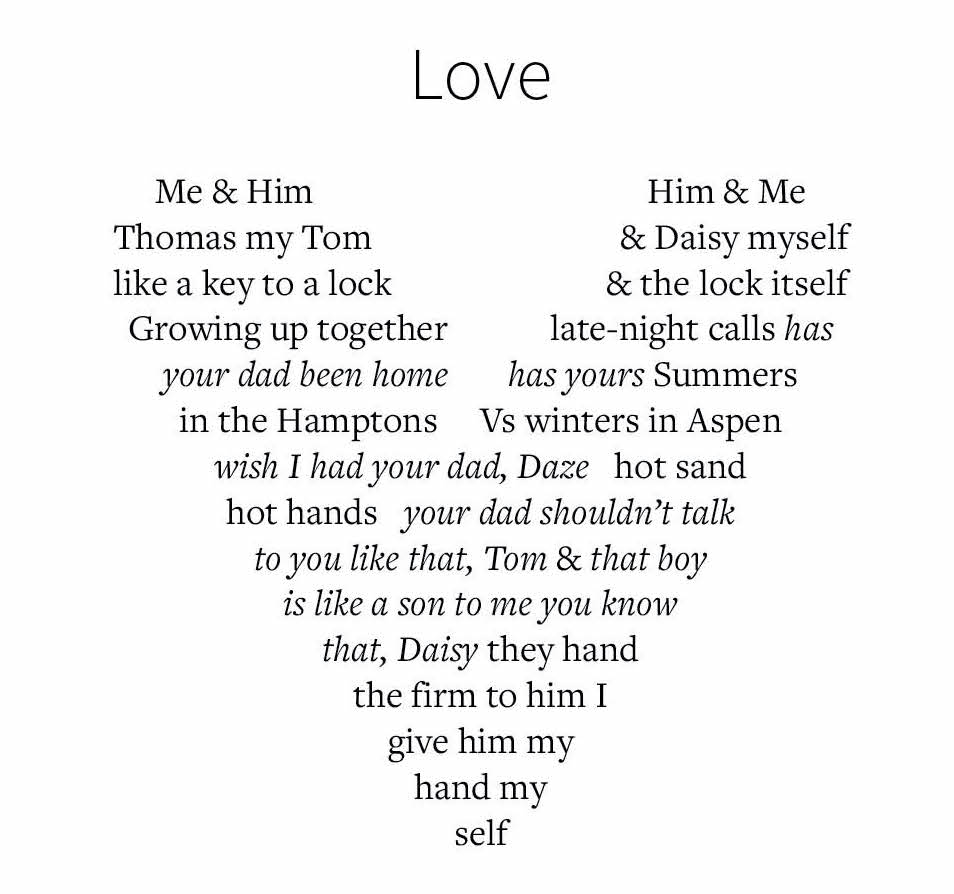Manage poetry with special shapes to meet the needs of print and electronic versions.
If a poem has a special shape or requires customized spacing, its rendering may be difficult to match in a reflowable ebook. This procedure allows for adjustments to be made when typesetting to establish the proper appearance of the poem. After finalizing the poem for print, there will be a static or “concrete” version of the poem available for the ebook that shows its special shape while still providing searchable text that a machine can read, along with alt text that describes the important visual aspect.
Examples shown are from “Love.” Copyright © 2025 by Rachel Feder. Published 2025 by TriQuarterly Books/Northwestern University Press. All rights reserved.
Initial Preparation
Before doing anything else to the manuscript, output the Word document as a PDF so that there is a static reference of the poem’s shape.
See Short Description Text (Alt Text) for more information on how to write and add alt text to files.
Scribe the Poem
Scribe the poem. Use distinct senseline styles for spacing and indentation; use nonbreaking spaces for extra spaces between words as necessary.
Do not use tabs in the middle of lines.
In some cases, tabs may be necessary at the start of lines, but they should be avoided in favor of using unique sl styles if possible.
Note: Once scribed, the Word document will not look like the source manuscript or intended final rendering. To avoid confusion, it may be beneficial for authors to defer any review of the poems until the first pages stage of the typeset.
Typeset the Poem
Typeset the poem in InDesign to achieve the desired rendering. Due to differences in available space and the font used, the number of nonbreaking spaces may need to be adjusted when typesetting to achieve the desired rendering.
Prepare the Image and Alt Text
Save the poem as a jpeg image.
In the .sam or .scml file, add alt text for the image. Keep the alt text simple and just describe the reason the poem is an image.
Example:
<fig><img src="nup-feder-poem01love.jpg" alt="This poem is shaped like a heart."/></fig>

Assemble the Content in ScML
After the image, place the poem as live text, which will enable read-aloud technology to read the poem to the user.
Scribe each line with top-level senseline styles (slf, sl, sll). Remove any tabs or spaces from the start of lines. Spaces within lines can be kept or resolved to single spaces.
Optional: Add a head before this text. If adding a head, it is recommended that this head is scribed as hd and says “Text of poem:” (but any phrasing is acceptable).
If each poem is the entire chapter, the title of the poem should be the chapter title, scribed as ct.
If the poem appears within the chapter, the poem’s title should be slh and appear as live text, not part of the image.
In the .scml file, comment out (but do not delete) the text of the original poem that was replaced by the image. When processing the file to ePub, only the image and the simply formatted version of the poem will be shown.
<chapter id="ch01">
<ct><page id="p1"/>Love</ct>
<figure>
<fig><img src="nup-feder-poem01love.jpg" alt="This poem is shaped like a heart."/></fig>
</figure>
<hd>Text of poem:</hd>
<senseline>
<!--<sl>Me & Him Him & Me</sl>
<sl>Thomas my Tom & Daisy myself</sl>
<sl>like a key to a lock & the lock itself</sl>
<sl>Growing up together late-night calls <i>has</i></sl>
<sl><i>your dad been home</i> <i>has yours</i> Summers</sl>
<sl>in the Hamptons Vs winters in Aspen</sl>
<sl><i>wish I had your dad, Daze</i> hot sand</sl>
<sl>hot hands <i>your dad shouldn’t talk</i></sl>
<sl><i>to you like that, Tom</i> & <i>that boy</i></sl>
<sl><i>is like a son to me you know</i></sl>
<sl><i>that, Daisy</i> they hand</sl>
<sl>the firm to him I</sl>
<sl>give him my</sl>
<sl>hand my</sl>
<sl>self</sl>-->
<sl>Me & Him Him & Me</sl>
<sl>Thomas my Tom & Daisy myself</sl>
<sl>like a key to a lock & the lock itself</sl>
<sl>Growing up together late-night calls <i>has</i></sl>
<sl><i>your dad been home has yours</i> Summers</sl>
<sl>in the Hamptons Vs winters in Aspen</sl>
<sl><i>wish I had your dad, Daze</i> hot sand</sl>
<sl>hot hands <i>your dad shouldn’t talk</i></sl>
<sl><i>to you like that, Tom</i> & <i>that boy</i></sl>
<sl><i>is like a son to me you know</i></sl>
<sl><i>that, Daisy</i> they hand</sl>
<sl>the firm to him I</sl>
<sl>give him my</sl>
<sl>hand my</sl>
<sl>self</sl>
</senseline>
</chapter>
Add an Editor’s Note
Add an editor’s note early in the book, scribed as eds.
It is recommended to place this editor’s note at the end of the table of contents.
<eds>Due to their visual components, some poems are presented as images. In those instances, the text of the poem follows each image.</eds>